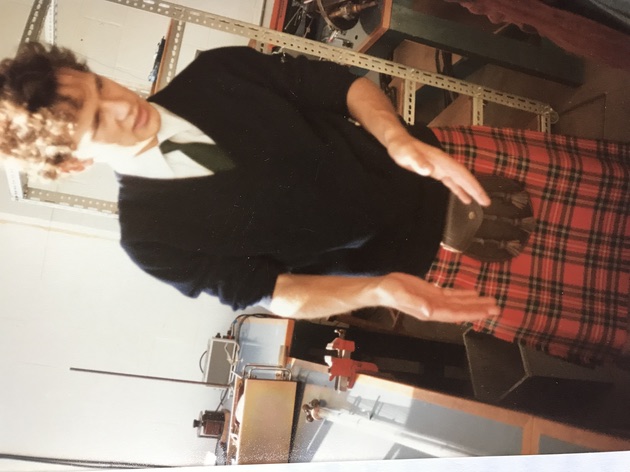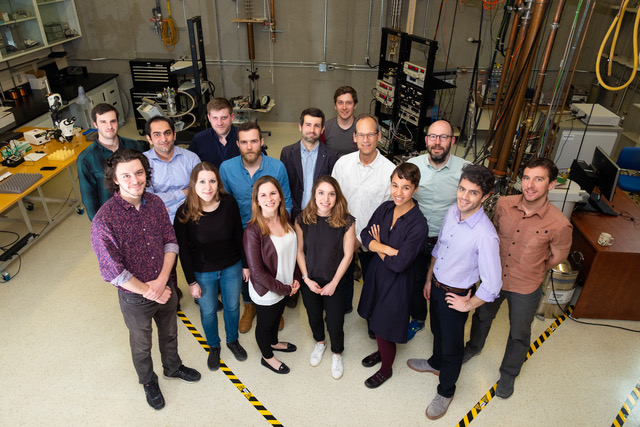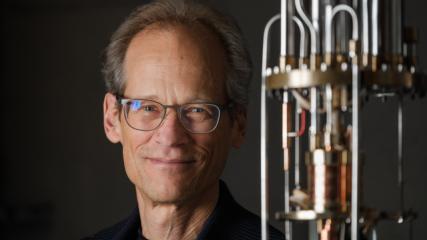Physicist Professor Louis Taillefer made Fellow of the Royal Society
Corpus alumnus recognised for his pioneering work in superconductivity and international collaborative research.
When Louis Taillefer arrived in Cambridge for the first time in 1982 he was immediately smitten with the city. Accompanied by his twin brother Eric, the pair arrived at the train station with their bicycles and hailed a taxi to bring them to Corpus.
“It was one of the most moving days of my life,” he says. “I had never been to Europe before. We put our luggage in the taxi and followed on our bikes. I could barely keep an eye on the taxi, I was just looking around and thinking how very old and very beautiful it was.”
Louis had come to do an MPhil in Physics, but he had originally planned to be at the other Cambridge, in Massachusetts, for his PhD. A year earlier both he and Eric were finishing their undergraduate degrees at McGill University in their home town of Montreal and were preparing to do postgraduate work. Louis was all set to go to Harvard when his brother came home with two applications for a Commonwealth Scholarship to study at the University of Cambridge. Eric was accepted at Trinity to do a PhD in Maths, and Louis was offered a place at Gonville and Caius.
As a Canadian, Louis had no idea about the Cambridge collegiate system, so he consulted one of his McGill professors, John Ström-Olsen (m1960) who had himself gone to Corpus. Ström-Olsen told him about the wonderful graduate accommodation at Leckhampton, which convinced Louis to ask for a transfer from Caius to Corpus.
“My brother’s rooms were not ready when we arrived, so he came to stay with me for the first few weeks. We showed up at the porters’ lodge on Trumpington street and I was amazed that they immediately gave me the keys to my room in the George Thompson building without asking for any proof of identification.”
The arrival of identical twin French-Canadian graduate students was unlikely to have been a common occurrence for the Porters and they were somewhat flummoxed by the pronunciation of the brothers’ surname.
“They looked at my name on their list with all its vowels and addressed me as ‘Mr Tailfeather’. For the next five years I had to explain to people how to say my name correctly. But I thought it was charming.”
From Leckhampton to the lab
Louis was assigned a project by his supervisor, Professor Gil Lonzarich, a solid-state physicist who founded the Quantum Matter Group at the Cavendish Laboratory. At that time, Lonzarich was working with magnetic materials, subjecting them to varying heat and pressure to undergo phase changes to new states of matter. In particular, Lonzarich suspected that under such forces certain materials could become superconducting, a phase of matter when electrons spontaneously pair together, enabling them to move smoothly through the material with no electrical resistance. Since the early 20th century, scientists had been exploring the properties of various superconductive metals, alloys and compounds.
“After eight months of working on my initial project, I went to Gil and told him I didn’t really see the point of it. When you are young, you want to find meaning in your work. So to his credit, he told me to drop that project and work with him on this theoretical project about magnetism. That soon got me interested in some big questions and I stayed on to do my PhD in research.”
That PhD research led to a breakthrough in the field. Typically, materials become superconductive at extremely low temperatures, when their electrons pair and reach a coherent quantum state. But a key question was how to measure the behaviour of those electrons when they reach this quantized state.
“The most fascinating materials at that time were the heavy fermion compounds. When an electron moves through a material it interacts with the environment, which slows it down, increasing its (effective) mass. These fermions have the heaviest mass. Quantum oscillations are the clearest signature of electrons in a metal. So I was looking for signs of those oscillations in a heavy fermion compound to see what kind of interacting electrons form that quantum state.”
To do this, Louis placed a sample of heavy fermion material in a refrigeration unit and cooled it to near absolute zero whilst subjecting it to a powerful magnetic field. A sensor recorded voltage changes that would indicate the quantization of the electrons.
“Quantum oscillations are beautiful, exciting things to observe, but I didn’t know if I would be able to see them. It depended on so many factors. So the first time I saw the needle shift, it was so incredibly moving. It’s like the electrons were speaking to me, saying this is what we do, this is how we behave.”
Five years in Cambridge – and a surprising hobby
Louis went on to complete his PhD at the Cavendish in 1986, then did a Junior Research Fellowship at Jesus College, leaving before his term was complete to take up a postdoc in Grenoble, France.
“Cambridge was such a great time in my life — at the human level for making friends, at the scientific level for making discoveries.”
Eschewing the typical Cambridge activities like rowing or rugby, Louis searched for a classical dance school in Cambridge where he could continue his previous ballet studies. Unable to find a suitable place to practice his jetés, he took up Scottish dancing instead, eventually becoming President of the Cambridge and Oxford Scottish Dancing Society (his name can still be found on the CU Strathspey & Reel Club website).
 “It turns out I had a kilt. And if you have ballet training it’s perfect for Scottish dancing. We practised contredanse, which is quite formal and has its origins in the Court. I ended up going to a two-week school at St. Andrews and then we toured the country. I visited England and Scotland by going to balls in grand country houses.”
“It turns out I had a kilt. And if you have ballet training it’s perfect for Scottish dancing. We practised contredanse, which is quite formal and has its origins in the Court. I ended up going to a two-week school at St. Andrews and then we toured the country. I visited England and Scotland by going to balls in grand country houses.”
Photo: a bekilted Louis is showing visitors around his lab at the Cavendish.
New school, new students and new superconductors
After some years in Grenoble, Louis returned to McGill University as an Assistant Professor in 1992. In 1998, he was recruited by the University of Toronto to build a group in quantum materials. He describes that time as a golden period for his research, with ‘brilliant students’.
One of those students in Toronto was Michael Sutherland, now a Fellow of Corpus and Admissions Tutor. Michael is based in the Quantum Matter group at the Cavendish, where he works with a family of copper oxides discovered in 1986 called cuprates. Cuprates are man-made materials, stacks of copper and oxygen lattices in hundreds of different variations, often sandwiched between elements like strontium and barium. These intriguing ceramics were to open up new avenues of research in superconductivity.
Superconductors are typically used to create powerful magnetic fields deployed in medical imaging such as MRI machines, or in particle accelerators where hundreds of giant magnets direct the trajectory of charged particles to make them collide. But conventional superconductors have a very low critical temperature, which means they need to be cooled with liquid helium. This is not only costly, but they must be shielded and insulated from the outside — the reason why MRI machines are so bulky. For decades physicist have looked for materials that could be coaxed into superconductive states at higher temperatures, which would lead to a considerable savings both of energy and of money.
“Mike did his PhD on these new materials with much higher critical temperatures reaching as high as half of room temperature (150 Kelvin, - 123 °C). Mike was an exceptional student. He is a world expert in measurements of the thermal conductivity of superconductors.”
Much of Louis’s research since his Toronto days (he moved to the Institut Quantique at L'Université de Sherbrooke in 2002) has continued this investigation of the behaviour of electrons in cuprates.
“When electrons bind together in pairs and enter a quantum coherent state, there is a force that holds them together. The stronger that force, the stronger the superconductivity and the higher the temperature where you could make it persist. We have actually come to understand the nature of the superconductive state quite well. Now we are looking more closely at what causes the electrons to pair.”
 The answers to this, says Louis, lie in studying the underlying metallic state that precedes the superconducting state. To do so, Louis and his group travel to High Magnetic Field facilities around the world where they experiment by exposing the materials to very powerful magnetic fields.
The answers to this, says Louis, lie in studying the underlying metallic state that precedes the superconducting state. To do so, Louis and his group travel to High Magnetic Field facilities around the world where they experiment by exposing the materials to very powerful magnetic fields.
“The metallic state is very mysterious. These cuprates have become a subject of great curiosity amongst physicists because they exhibit all kinds of ill-understood phenomena. For instance, there’s a phase we could call the ‘dark phase of quantum matter’ for we don’t understand it well at all. We know it’s there, we can see the signatures, but we do not have a good understanding of its essential nature. The more we dig, the more puzzles we find.”
Photo: Louis and his group in the lab at the University of Sherbrooke.
Discoveries uncover further mysteries
Louis and his group have just released a paper in Nature, Linear-in temperature resistivity from an isotropic Planckian scattering rate, which describes one such puzzle, dubbed Planckian dissipation. The relationship between resistance and temperature in a metal usually follows a curve, the material becoming less resistive as the temperature drops and the electrons undergo fewer collisions between themselves. But in some cuprates, that relationship follows a straight line. In the paper, Taillefer and his coworkers show that the linear temperature dependence of the resistivity derives from a scattering time between electron collisions that is limited by Planck’s Constant, the fundamental unit of the quantum world.
“This is a very puzzling and fascinating time constraint in metals, which may be correlated with another instance in which Planck’s constant seems to be the limiting factor in the relaxation of black holes. Physicists studying string theory and black holes are interested in these metals because there’s a parallel between these two phenomena.”
The research behind the paper was partially funded by the Canadian Institute for Advanced Research (CIFAR), where Louis has been Director of the Quantum Materials Programme since 1992.
“CIFAR is quite unique. It is a private organisation that brings together scientists from around the world – experimentalists, theorists and material scientists — to spark discoveries. I am committed to international collaboration and CIFAR has been extremely effective at sparking discovery.”
“When the Royal Society contacted me I told them that I want to contribute by helping to foster international collaboration. That’s one of the Society’s missions, and one I feel leads to great scientific outcomes.”
In this spirit, Louis is involved in the creation of a new international research lab in Sherbrooke in collaboration with the French Centre national de la recherche scientifique (CNRS). Louis will become the Director of the Quantum Frontiers Lab in 2022.
“To me, the most exciting thing about physics is the sheer discovery of a new phenomenon that has never been seen. You don’t know where that is going to come from. It’s inevitably a surprise. The field of superconductors is a very active field and people from all corners of the scientific community are pushing in all directions. In the broader field of quantum materials, there could be an infinite number of new, remarkable, and potentially very useful applications, from energy-generating turbines to quantum computers.”
About Louis
Louis Taillefer is the Canada Research Chair in Quantum Materials at the University of Sherbrooke, Québec, where he leads a research group specialized in the experimental investigation of superconductors and correlated electrons at very low temperature and in high magnetic fields.
Awards
Kamerlingh Onnes Prize, 2018
Simon Memorial Prize, 2017
Killam Prize, 2017
Officer, Ordre national du Québec, 2012
Member of the Order of Canada, 2010
Recorded lectures
The Dark Phase of Quantum Matter 22 April 2021
New signatures of the pseudogap phase of cuprate superconductors 15 October 2020
Public lectures
2020 Public Lecture, Simons Foundation, New York, USA (online)
2015 Public Lecture, M2S 2015 conference, Geneva, Switzerland
2014 APS TV – video on CIFAR Quantum Materials Program at APS March meeting
